When it comes to hooking your target fish, selecting the correct lure bait is key. Fish species have different feeding habits and preferences. Selecting the right presentation will greatly improve your chances of landing a prize catch. When selecting a bait, the first decision to make is whether to use natural or artificial bait. Most fish prefer natural bait. However, artificial bait and lures can be very effective for catching most fish species. The following chart provides a list of the most common natural baits and artificial lures. To explore bait recommendations for individual game fish species visit our freshwater game fish and saltwater game fish guides.
| Lure / Bait | Example | Fishing technique | Target species |
|---|---|---|---|
| Crankbait |  | Casting, Trolling | Largemouth bass, Smallmouth bass, White bass, Striped bass, Northern Pike, Muskellunge, Trout, Walleye, Perch, Crappie, Panfish |
| Plugs |  | Casting, Trolling | Bass, Pike, Muskellunge, Snook, Redfish, Spotted Seatrout, Tarpon, King Mackerel, Grouper, Tuna, Mahia Mahi, Wahoo |
| Jerkbaits |  | Casting, Trolling | Bass, Pike, Muskellunge, Snook, Redfish, Spotted Seatrout, Tarpon, King Mackerel, Grouper, Tuna, Mahia Mahi, Wahoo |
| Jigs |  | Casting, Vertical fishing, Ice fishing | Bass, Trout, Walleye, Muskellunge, Pike, Kokanee Salmon, Perch, Crappie, Bluegill, Panfish, Snapper, Grouper, Amberjack, Tuna, Cobia, Mackerel |
| Spinnerbaits | 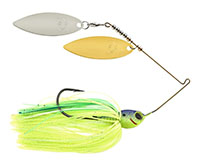 | Casting | Bass, Northern Pike, Muskellunge, Perch, Trout |
| Inline spinners |  | Casting, Trolling | Trout, Salmon, Bass, Northern Pike, Muskellunge, Walleye, Salmon, Crappie, Bream, Sunfish, Panfish |
| Topwaters |  | Casting | Trout, Northern Pike, Pickerel, Muskellunge, Largemouth bass, Smallmouth bass, Striped bass, Spotted Seatrout, Snook, Refish, Bluefish, Bonefish, Barracuda |
| Soft plastics |  | Casting, Finesse techniques, Ultra light fishing, Trolling | Largemouth bass, Smallmouth bass, Striped bass, Hybrid bass, White bass, Trout, Perch, Bluegill, Crappie, Panfish |
| Spoons |  | Casting, Trolling, Ice fishing | Largemouth bass, Smallmouth bass, Northern Pike, Muskellunge, Walleye, Salmon, Trout, Mackerel, Kingfish, Blackfin Tuna, Wahoo, Mahi Mahi |
| Swimbaits |  | Casting, Trolling, Vertical fishing, Ice fishing | Largemouth bass, Smallmouth bass, Spotted bass, Walleye, Northern Pike, Muskellunge, Trout, Crappie, Panfish |
| Blade baits | 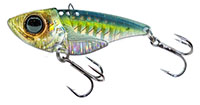 | Casting, Vertical fishing, Trolling, Ice fishing | Largemouth bass, Smallmouth bass, Spotted bass, Walleye, Sauger, Northern Pike, Muskellunge, Yellow Perch, Crappie, Panfish, Trout, Stripers |
| Chatterbait |  | Casting | Largemouth bass, Northern Pike, Muskellunge |
| Trolling lures |  | Trolling | Lake trout, Bass, Salmon, Walleye, Muskellunge, Tuna, Snapper, Mahi Mahi, Mackerel, Sailfish, Blue marlin, Billfish, Kingfish, Wahoo, Barracuda |
| Flies |  | Fly fishing, Casting, Finesse fishing, Trolling, Ultra light fishing | Trout, Largemouth bass, Smallmouth bass, Steelhead, Salmon, Northern Pike, Panfish, Carp, Redfish, Snook, Tarpon, Bonefish, Striped bass, Marlin, Wahoo, Sailfish, Wahoo, Tuna |
| Bread and Dough Balls | 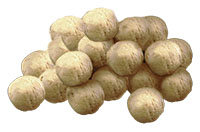 | Bait casting, Bottom fishing, Still fishing | Chub, Carp, Catfish, Suckers, Sunfish, Bluegill, Crappie, Panfish (freshwater and saltwater), Scavenger fish |
| Clams and Mussels |  | Bait casting, Bottom fishing, Surf casting, Chumming, Drift fishing | Flounder, Sea trout, Blackfish, Striped bass, Porgy, Whiting, Rock fish, Perch, Bass, Stripers, Catfish, various saltwater and freshwater species |
| Crabs |  | Bait casting, Bottom fishing, Surf casting | Redfish, Snook, Cobia, Pompano, Black drum, Rays, Shark, Tautog, Corbina, Grouper, Croaker, Flounder, Sea bass, and more. |
| Crayfish |  | Baitcasting, Bottom fishing, Bottom bouncing, Fly fishing | Largemouth bass, Smallmouth bass, Catfish, Trout, Salmon, Herring, Perch, Walleye, Carp |
| Cured Fish Roe | 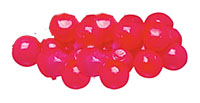 | Baitcasting, Bottom fishing, Fly fishing | Salmon, Steelhead, Trout, Sturgeon |
| Cut Bait |  | Baitcasting, Bottom fishing, Jigging, Trolling | Carp, Freshwater drum, Perch, Bluegill, Herring, Trevally, Various freshwater and saltwater fish species |
| Eel Bait |  | Baitcasting, Surf casting, Trolling | Cobia, Chinook, Salmon, Steelhead, Striped bass, Sharks, Grouper, Barracuda |
| Grubs and Meal Worms |  | Jigging, Bottom fishing, Casting, Still fishing | Bass, Perch, Walleye, Bluegill, Crappie, Sunfish, Panfish, Trout, various saltwater fish species |
| Insects |  | Jigging, Bottom fishin, Casting, Still fishing | Bass, Perch, Walleye, Bluegill, Crappie, Sunfish, Panfish, Trout, various saltwater fish species |
| Leeches | 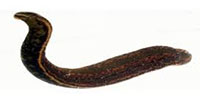 | Casting, Bottom fishing, trolling | Walleye, Smallmouth bass, Pike, Trout, Panfish |
| Live Saltwater Fishing Bait |  | Jigging, Baitcasting, Trolling, Bottom fishing, Surf casting | Most saltwater game fish species |
| Minnows | 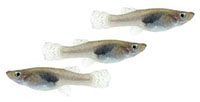 | Baitcasting, Bottom fishing, Drift fishing, Trolling | Bass, Crappie, Chain pickerel, Trout, Perch, Bluegill, Pike, Catfish |
| Shrimp | 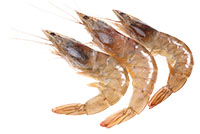 | Drifting, Bottom fishing, Trolling, Still fishing, Baitcasting | Seabass, Sea bream, Redfish, Wahoo, Cobia, Speckled seatrout, Snook, Flounder, Catfish, Bullheads, Bass, Walleye, Crappie, Perch, Bluegill, Anywhere shrimp are natural food source |
| Squid |  | Jigging, Baitcasting, Bottom fishing, Drift fishing | Sharks, Mackerel, Kingfish, Tuna, Little tuny, Grouper, Snapper, Bass and various other saltwater game fish. Freshwater: Catfish, Bullheads, Bass, Panfihs, Salmon, Trout, Pike |
| Worms |  | Baitcasting, Still fishing, Drift fishing, Bottom fishing | Bass, Trout, Crappie, Bluegill, Perch, Panfish, Catfish, Carp, and various saltwater species. Most fish will take a worm. |
Crankbaits
A crankbait is hard-bodied casting lure that mimics a baitfish. It is used to target predatory game fish species, such as bass or pike, that feed on smaller baitfish.
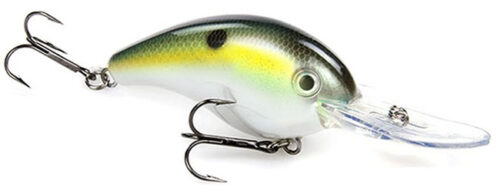
The crankbait has a bill/lip at the head end of the lure. The size and angle of the lip, as well as the buoyancy of the lure, determine its diving depth. A crankbait can be fished at depths of two to 30 feet.
The body of a crankbait can be either wide or narrow. A wide body crankbait produces a wide wobble as it is retrieved. A narrow crankbait produces a tighter wobble. On its underside a crankbait is fitted with two or three sets of treble hooks.
The following table includes the six types of crankbait lures.
| Lipless crankbait | Versatile crankbait that can dive between 2' to 30'. Performs well in weeds. |
| Square bill crankbait | Are typically for shallow fishing at depth 2' to 8'. Perform well in structure. |
| Round bill crankbait | Are typically medium diving crankbait. Average dive depth is 10' to 30' depending on the angel of the bill. |
| Shallow diving crankbait | Typically have a small lip and are best fished at 2' to 5'. |
| Medium diving crankbait | Have medium size lip and can be fished from 5' to 15' |
| Deep diving crankbait | Typically have a larger lip and are fished at depths anywhere from 12' to 30' |
Plugs
A plug is a hard-bodied casting and trolling lure similar to a crankbait. Plugs are typically shorter, deeper-bodied lures designed to imitate baitfish, frogs and other prey. They typically have a bill/lip at the line end of the lure. Plugs are often referred to as wobblers.
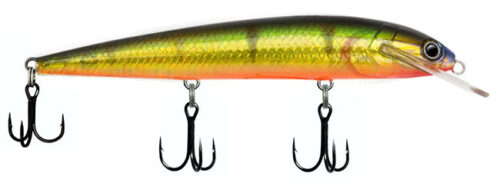
Plugs can be fished shallow or deep. The depth a plug is fished is determined by several factors including lure bouyancy, lip angle and size, and retrieval rate. Plugs can be fished from the water’s surface to depths of over 30 feet.
Plugs have a variety of designs and functions. A traditional plug floats at the surface or suspends in the water, but will dive under the water and wobble side-to-side as it is retrieved. The movement of the plug resembles that of a baitfish.
Plugs come in various sizes for targeting different game fish. They range in size from 1 inch for small fish to over 8 inches for larger fish. 2-3 inches is the most common plug size.
The following table shows the four most common plugs for freshwater and saltwater fishing.
| Topwater plug | Typically have a hollow body with a set of treble hooks at either end. Are retrieved along on the surface of the water. |
| Minnow plug | Mimic injured or swimming minnows. Should be selected to match the natural baitfish for the target game fish species. |
| Shallow-diving plug | These include suspending twitchbaits and jerkbaits. Great for inshore species including snook, redfish, spotted seatrout and tarpon. Fish up to depth of 10'. |
| Deep-diving plug | Typically have larger plastic lips with allow them to reach depth of up to 40'. Designed for larger saltwater fish. |
Jerkbaits
Jerkbait are similar in design to a crankbait or plug. They are minnow-shaped lures that mimic baitfish. However, where crankbaits are shorter and fatter, jerkbaits tend be slender and longer. Additionally, crankbaits have two treble hooks where most jerkbait have three treble hooks.
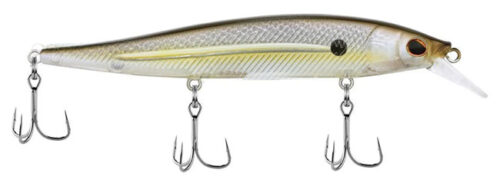
Jerkbaits have smaller bills when compared to the longer, wider bill of crankbait. Given the smaller bill size, jerkbaits don’t dive as deep as some crankbaits. The bill of a jerkbait may be square, diamond-shape, or rounded. As with crankbaits, some jerkbait are lipless.
There are three basic types of jerkbaits. These are outlined in the following chart.
| Suspending jerkbait | Are designed to remain in the same position in the water column between the surface and bottom. This lure will not rise or fall. Position can be adjusted by jerking the rod. |
| Floating jerkbait | A versatile lure that floats at the surface but will dive under the water when jerked. Is a great year-round lure for fishing bass. |
| Sinking jerkbait | Will sink until the angler jerks the rod. This is the ideal jerkbait for times of the year when you need to get your bait deeper in the water column. |
Jigs
A jig is a weighted fish lure composed of a single hook attached to a metal or lead sinker, referred to as a jighead. A jig is often fitted with a decorative plastic skirt, encased in a soft plastic lure, or ammended with feather-like attractors. It is one of the simplest, yet effective, fishing lures and used by anglers to catch a wide variety of freshwater and saltwater game fish.
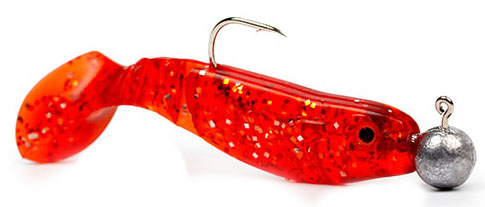
As opposed to other lures such as swimbaits, plugs, spoons and spinnerbaits that move more or less horizontally through the water, a jig is worked up and down vertically through the water column. The vertical jerky motion of the jig is what attracts fish. Jigs are worked up and down using rapid lifting motions with the fishing rod.
The jighead comes in many different shapes and colors. It is typically round, but can also be cone-shaped, cylindrical, fish-head shaped, or resemble a spoon or spinnerbait. Jigheads are most prominent on large jigs and typically used with soft plastics.
The following table lists seven of the most popular types and shapes of fishing jigs.
| Casting jig | All-purpose jig. Has round, flat-bottom, or Arkie style head to allow it to stand upright on the bottom. Can fish with a jig trailer for craws, grubs, or creatures. 3/8 to 1/2 ounces. |
| Swim jig | Has a bullet-shaped head, vertical line tie and light weed guard to allow it to cut through the water column and avoid snags. Use during the spring and fall. Ranges from 1/4 to 1/2 ounces. |
| Flipping jig | Designed to be fished in heavy cover without snagging. Ranges fro 3/8 to 1 ounce. Best with compact head shape with recessed line tie. Should have firm weed guard. Can include rattle and trailers. |
| Football jig | Has football shaped head that allows it roll over rocky bottoms without catching. Best weight is between 3/8 and 1 ounce. Should use wide gap hook with a full skirt (grubs, craws, and creature baits.) |
| Grass jig | Have a conical head with vertical line tie that allows them to penetrate grass. Fished on heavy tackle with heavy hook. Should be compact with minimal appendages. |
| Finesse jig | Designed for smaller fish. Excels in high angler pressure and colder water. Typically between 3/16 and 1/4 ounces. Has light hook with finesse or spider cut skirt. |
| Punch jig | Specialized flipping jig designed to be fished in matted grass or wood cover. Should be fished with braided line to cut through grass and weeds. Between 3/4 to 2 ounces. |
Spinnerbaits
A spinnerbait is a lead head molded onto a hook (similar to a jighead) attached to an “L” shaped wire are that holds up to 4 blades. As the spinnerbait is retrieved through the water the medal blade or blades spin around the wire arm or on a swivel attached to the wire.
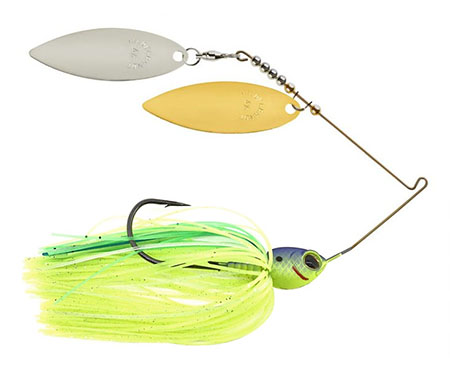
In calm, clear water, a spinnerbait can attract game fish from a considerable distance. The spinnerbait is most commonly used to catch large predatory freshwater fish such as bass, pike, and muskie. Smaller spinnerbaits can also be used to target smaller game fish such as perch.
The blade is the key feature of the spinnerbait. As the medal blades spin they create vibration, noise and flash that attracts predatory fish such as bass, pike, walleye, and trout. There are four types of blades used for spinnerbait. These include willow leaf, Colorado, Oklahoma, and Indiana.
There are several types of spinnerbait lures. The most popular are listed in the following table.
| Safety Pin (Overhead Arm) Spinner | The most popular and well known spinnerbait design. Has a wire frame bent at 90 degrees with a cone, arrow or bullet shaped lead body. Used for fishing bass, northern pike and redfish. |
| In-line Spinner | A simple lure where one or more blades spin around a center axis or wire just below the eye. The popular spinnerbait ideal for fishing predatory fish, especially trout. |
| Tail Spinner | A versatile spinnerbait that can be fished horizontally through the water column of jigged vertically. Has a weight forward design with a treble hook at the front near the line tie and the blade at the tail end. |
| Beetle Spin | Has small jig head attached to an L-shped wire arm with 90 degree bend extending to the blade. The jig head can be tipped with a soft plastic or live bait. Used to catch bass and small predatory fish. |
| Live Bait Spinner Rig | Can be purchased or self-made. Has an extended harness with one or more rotating blades, colored beads and one or more baited hooks. Can be configured in various ways for cast and retrieve, drift fishing, or trolling. Used for a variety of cold and warm water game fish species. |
Inline spinner
The inline spinner is a type of spinnerbait where the spinner blade is attached directly below the eyehole to the body of the lure. As the inline spinner is retrieved through the water both the blade and body of the lure spin to create a vibration and flash that attract predatory game fish.
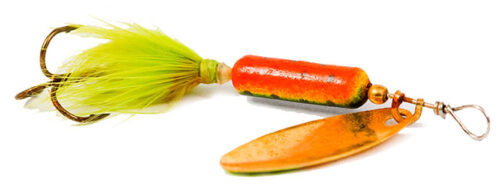
Inline spinners are used to catch a variety of game fish including bass, walleye, salmon, crappie, and muskies, but they are particularly effective for catching trout. The flash created by the spinning blade of the inline spinner mimics the shinny minnow that trout feed on in lakes and rivers.
Topwaters
A topwater lure, often referred to as a walker, includes any number of lures that are fished on the water’s surface. Most topwater lures by nature of their design are bouyant and float on the water’s surface. Non-floating topwater lures are not bouyant, but climb to the water’s surface upon retrieval.
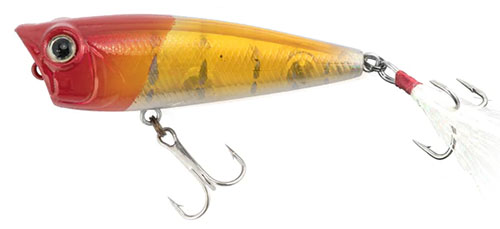
Topwater lures are designed to mimic baitfish and other prey items including insects, frogs, mice, or even snakes. Topwaters can be designed to mimic just about any surface dwelling prey of a target game fish species. While designs vary, almost all topwater lures exhibit a “walking” action as they move along the surface. The more life like the action, the more effective the lure.
Topwater lures will catch a large variety of freshwater and saltwater game fish species including everything from Largemouth bass to Muskies to Spotted Seatrout. Topwater lures are particularly effective for catcing bass during the late fall and early spring during spawning season.
The following chart shows the nine topwater lures most commonly used by anglers.
| Walker | A topwater walker produces a back-and-forth or zig-zag motion on the surface when using the walk the dog retrieve. To make the lure walk, move the lure from side to side by making jerking motions with your rod as you reel. |
| Popper | Also known as a surface popper, this bait has a cupped face at the head of the lure that creating a popping action on the water's surface. Ideal to fish in small spaces. Popular variations include pencil poppers, fly poppers, finesse poppers and popping corks. |
| Wakebait | Produces a V shaped wake when retrieved that draws in large fish from a distance. Has an angled lip the causes the lure to shimmy back and forth on the surface or just under the surface. |
| Twitchbait | Mimic an injured minnow. Anglers can twitch and float a twitchbait to the surface to entice a surface strike. Work best on clear lakes with high fishing pressure in areas where there are bass. |
| Prop bait | Long slender baits with propellers on either end. Typically have 2 to 3 treble hooks. Fish using short jerks to spray water. Create a lot of action without much forward movement required. |
| Buzzbait | Similar to a spinnerbait. Has a lead head, skirt and wire arm that extends up and over the head. Has a prop blade attached to the end of the arm that spins as the lure is retrieved. Gurgles water as retrieved and sprays when jerked. Fish along grass lines, rip rap banks and areas with cover. Ideal for late sumer and early fall. |
| Frog | A snag free soft plastic topwater bait that mimics a frog swimming across the water's surface. Used to target bass in matted vegetation, dense grass and around cover. |
Soft plastics
Soft plastic bait, also known as soft plastic lures, rubber worms, or simply soft plastics, refers a variety of flexible, life-like lures made of elastomer-based soft plastic. Soft plastics are available in a rainbow colors, sizes, and shapes. Soft plastics can be used with various hook sizes, fishing rigs and fishing techniques.
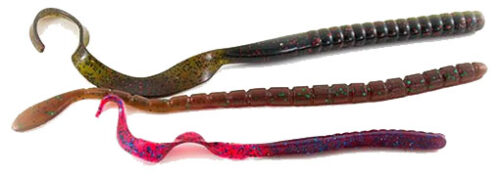
Soft plastics are designed to mimic baitfish, crawdads, frogs, worms and other common prey items. Given their versatility, life-like appearance, and low cost, soft plastic baits are one of the most popular artificial fishing lures used by anglers. Soft plastic bait is often fished with a jighead or as part of a more complex fishing rig (e.g. Texas rig and Carolina rig).
The most common presentation of soft plastic bait is a simple lure, using a jighead. The hook end of the jighead is threaded through the soft plastic bait leaving only the gape of the hook and eye exposed. Techniques for fishing soft plastics range from cast and retrieve to trolling.
The thirteen soft plastic baits listed in the following table can be used for fishing most species predatory freshwater fish as well as a large variety of saltwater fish.
| Worms | The most popular and versatile soft plastic bait. Can be used for targeting just about any fish species. Commonly used in more complex presentations such as a the Texas rig and Carolina rig. |
| Creature baits | Is a soft plastic lure with multiple appendages. As the creature bait moves through the water it creates a natural action that mimics a swimming fish. Ideal for bass fishing. Typically 3-6 inches long. |
| Tube baits | Tube bait is hollowed out soft plastic with tenancles for a tail. This is the go-top soft plastic bait for many bass anglers and works well for catching a variety of freshwater and saltwater game fish. It can be fished using a jighead or on a texas rig using a sinker and extreme wide gap (EWG) offset worm hook. |
| Craws | Craws are soft plastic bait designed to mimic crawfish. These are a favorite bait of largemouth and smallmouth bass. Craws are about 3-4 inches long and have two claw like appendages at one end. Fishing a craw on a texas rig is a effective presentation for targeting largemouth bass. For smallmouth try a smaller craw on shaky head rig. |
| Soft Swimbaits | Designed to mimic baitfish and prey swimming under water. Soft plastic swimbaits provide a more natural feel than hard baits when taken by a fish. |
| Soft jerkbaits | Mimic a baitfish or prey swimming under the water. They have narrow torpedo body and profile that makes them appear almost life like. They typically have 3 treble hooks attached to their underside. |
| Grubs | Are short, thick pieces of soft plastic that mimic grubs. They are effective soft plastic bait for fish of all sizes. Grubs are typically attached to a jighead but are also a common bait choice for a Texas rig, Carolina rig or drop shot rig. |
| Curl tailed | One of the most popular and effective soft plastic grub baits. A curly tailed lure flops and twists as it moves through the water. It is effective for fishing bass, walleye, pike as well as a variety of freshwater species. |
| Soft stickbaits | Is a simple 3-5 inches soft plastic bait that looks like a short stick or work. The soft stickbait is easy to fish. Just hook it through the middle and cast it into the water. Has a variety of rigging configuration but is most commonly used on a wacky rig. |
| Beavers | A soft plastic bait designed to be fished in thick cover. Has a ribbed oval body with tail flaps that allow it to maneuver in and out of the cover where bass live and hide. A great bait to fish in matted vegetation. |
| Frogs | Soft plastic bait that imitates a frog. Designed be fished on the surface over matted vegetation and in thick summer and fall grass. Employ a straight retrieve using a heavy braid or fluorocarbon line and offset worm hook. |
| Lizards | Popular soft plastic bait that can be fished throughout the spring, summer and fall. They're ideal for fishing for bass in the shallows weightless. |
| Trailers | Soft plastic trailers can be added to jigs, bladed jigs, spinnerbaits and buzzbaits to vary or enhance the lures vibration, movement and appearance to create a more enticing presentation. |
Spoons
A fishing spoon is a lustrous concave oblong metal lure shaped like a spoon. As it is retrieved through the water it produces a specular reflection and wobble that attracts predatory fish such as bass, pike, walleye, and billfish (e.g. marlin, swordfish, etc.) From afar, the reflection a spoon lure produces resembles the sparkling scales of a swimming or injured bait fish.
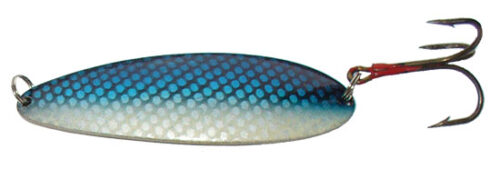
There are several types of fishing spoons. The most popular are listed in the following chart.
| Casting spoons | Casting lures are designed to support a traditional cast and steady retrieve fishing technique. They are made of a heavier material to support distance casting. |
| Trolling spoons | Trolling spoons are made of a lighter material and designed to be trolled slowly behind a boat. They are often fished as part of a rig for optimal presentation and depth control. There are two types of trolling spoons: slow speed and high speed. High-speed trolling spoons are narrower and heavier than slow-speed spoons. |
| Topwater spoons | Designed to be fished over cover. Retrieve at a rate that maintains the spoon on the water's surface. Ideal for targeting bass, pike and muskies that hide in thick cover. |
| Weedless spoons | Designed to be fished directly in thick cover, such as vegetation, without snagging. Equipped with a wire guard to prevent snags and hangups. Will accomodate a variety of fishing techniques. |
| Jigging spoons | An ideal lure for fishing deeper water. Allow the lure to drop to the bottom, then take up any slack in the line. Work the spoon up and down with short jerks. |
The most common technique for fishing a spoon is to cast the spoon beyond the point where a target fish is located and retrieve the lure through the strike zone.
Swimbaits
Swimbaits are lures designed to mimic baitfish and prey swimming underwater. There are two general categories of swimbaits: hard body and soft body.
Hard-body swimbaits are made of plastic or wood. These baits mimic types of baitfish that predatory fish such as bass, pike, and trout feed on. When retrieved through the water these baits produce a life like swimming action that attracts game fish and provokes a bit. Hard body swimbait can have a single joint or multiple joints.

Single joint hard-body swimbaits produce a serpentine action in the water. Multi-joint hard-body swimbaits produce a more natural, life like swimming action. Multi-joint swimbaits can have between 2 and 6 hinged joints. These lures are ideal for fishing flats, points and humps. They are typically rigged with treble hooks and do not do well in areas with lots of vegetation where they’ll likely snag.
Soft-body swimbaits are made of soft plastic or rubber. Soft-body swimbaits are also designed to closely mimic baitfish and other prey. Soft-body baits exhibit a more natural feel in the mouth of a game fish. These lures are designed to be cast out and retrieved slowly.
There are several types of soft-body swimbaits. These include paddle tails, line through, and top hook. Paddle tails can have either a solid or hollow body. They’re great for fishing in the weeds. Line through swimbaits allow the fishing line to run body of the bait. Line through baits are typically large and designed to target larger game fish. Top hook swimbaits use a jig style hook, are large, and utilize a wedge style tail designed for cold water fishing.
Swimbaits are most commonly used to target fish over 10 pounds, such as bass or larger fish. The most common size swimbait used by anglers is between 6″-12″.
Blade baits
A blade bait is a flat metal spoon (or “blade”) with a weighted nose. It has two sets of treble hooks, one at each end. It is similar in appearance to a crankbait but narrower. As the bait is retrieved through the water, or lifted through the water column, it produces a vibration that attracts predatory game fish.
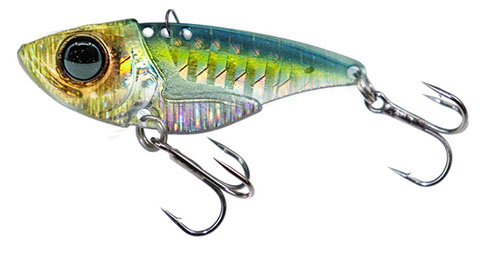
Blade baits are a common “go to” lure for anglers during the fall and winter when water temperatures cool. They’ll catch fish late in the year when other lures won’t. The best techniques for fishing blade baits are a (1) traditional cast and retrieve and (2) lift and drop. The lift and drop technique is simply lifting and dropping the blade bait through the water column.
Chatterbait
Also known as a vibrating or bladed jig, the Chatterbait has a unique design that looks a lot like a skirted jig with a small square piece of metal with trimmed corners attached to the eye. A chatterbait produces the flash of a spinnerbait and vibration of crankbait to attract a variety of predatory fish such as bass, pike, and muskies. It’s also a weedless lure that doesn’t snag easily. Its ideal for fishing heavy cover where bass, pike and muskies like to hide.
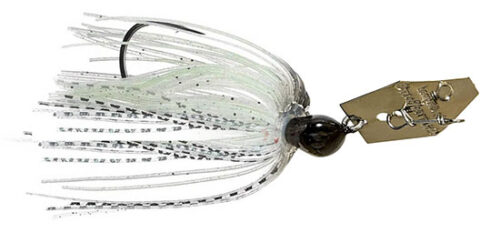
Chatterbait can be used in both shallow and deep water. This lure tends be most effective during fall and late winter, into early spring, with spring being the best time of year to fish a chatterbait. However, a chatterbait can successfully be fished year round with the right technique.
Some anglers will remove the traditional jig skirt and trailer from the chatterbait and retrofit the lure with a soft plastic bait. This is often a preferred presentation when targeting schooling fish or bottom fishing.
Trolling lures
Trolling lures are designed to mimic an injured or fast moving baitfish. Trolling lures may include surface lures, spoons, plugs, soft plastic baits, or spinnerbaits that are trolled behind a moving boat. There are also a number of specialized trolling lures used for targeting billfish and other saltwater fish species.

Trolling lures are typically attached to the main or leader line using an improved clinch knot or metal device called a “snap”.
Flies
A fly, or fly lure, is used primarily for fly fishing, although a fly may also be used for other types of angling. Flies are designed to mimic prey that are the natural food source for select species of game fish. Flies are created via “fly tying” which involves strategically arranging and attaching feathers, furs, thread and other material to a fish hook to create a pattern.
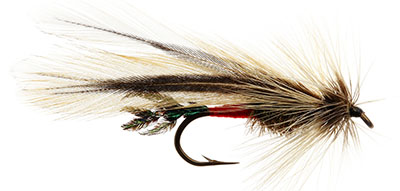
Flys can be designed to imitate a large variety of aquatic and terrestrial prey, including insects, worms, fly hatches, nymphs, crustacieans, baitfish, amphibians, small mammals and even birds. There are many thousands of fly patterns used for both freshwater and saltwater fishing.
There are two general categories of flies: imitations and attractors. Within these two categories are several subcategories of flies including dry flies, nymphs, streamers, eggs, and scuds. Imitation flies are designed to imitate the natural prey of a game fish. On the other hand attractors are design using bright colors and patterns to arrose an aggression response from a game fish.
The six most common flies for fishing trout, salmon, bass and saltwater fish are listed in the following table.
| Dry Flies | Small lures fished on the water's surface. Mimic adult aquatic insects emerging from the water as well as terrestrial insects such as ants, crickets and grasshoppers that have fallen into the water. |
| Nymphs | Imitate young aquatic insects in their larval form. Fished near the bottom of the water column in lakes and rivers. effect for catching trout, salmon, steelhead and panfish. |
| Streamers | These flies are fished under the surface throughout the water column. They imitate natural prey including baitfish, crayfish, leeches, etc. Streamers are very versatile and can be used to target a variety of freshwater and saltwater gamefish species. |
| Wet Flies | Fished below the water's surface at varying depths. Imitate insect larvae, crawfish, fish eggs, baitfish, leeches and other small prey creatures. Recommended when fish aren't feeding along the surface. |
| Salmon Flies | Designed to target Altantic and Pacific Salmon. Do not mimic specific prey. A designed to elicit an aggressive eresponse. Include a variety streamer and egg patterns. |
| Saltwater Flies | Saltwater flies are designed to mimic a large variety of prey and food sources found in the ocean including crustaceans, crab, and shrimp. Often used to target bonefish, permit and tarpon. Are larger than freshwater flies and heavier duty. |



